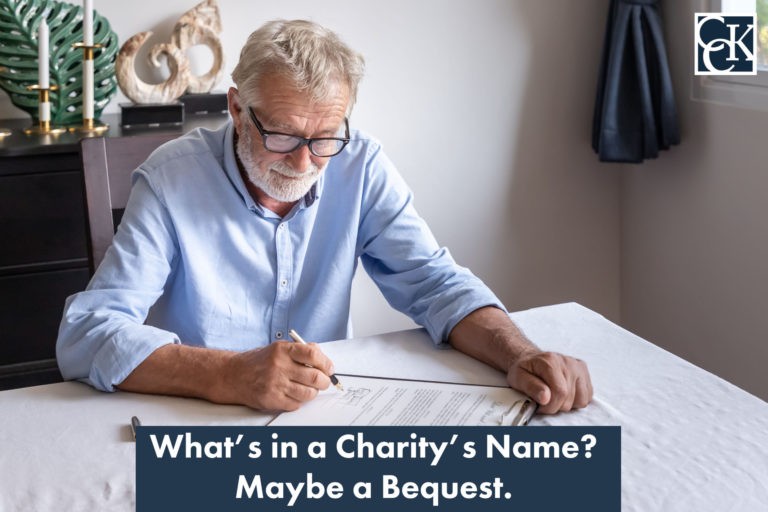What’s in a Charity’s Name? Maybe a Bequest.

Gift Planners’ Notes Are for More Than Sending Birthday Cards
To most who work in the “business” end of a charity, a gift planner’s file will seem curiously out of place in an organizational setting. The notes may contain information about a donor’s wealth, but are just as likely to feature birthdays, a puppy’s name, and even a favorite cake. These personal details, and more, form a record of the growth of the relationship between a charity and its supporter.
Cute notes, records of conversations, cards, and messages received from and sent to the donor and similar “relationship evidence,” properly preserved and dated, have the potential to become important information if, for example, a will turns out to be a little bit ambiguous. A recent New Jersey case illustrated how organizational naming can become a big issue.
The facts of the case (In re Estate of DeConca, 2020 WL 1492556 (N.J. Super. Ct. App. Div.)) are a little sketchy, but the basics are clear. Ms. DeConca was a supporter of the National Alzheimer’s Association (NAA, headquartered in Chicago) and included the organization in her estate plan as written in 2000.
Over time, she became more focused on the local branch of that organization in New Jersey (AANJ) and rewrote her will in 2009. She removed NAA as a beneficiary, replacing it with AANJ, although with a slightly skewed name.
Ms. DeConca appears not to have realized that AANJ had disassociated from the national parent and essentially become inactive. A new Alzheimer’s-related organization (AANJ#2) was now operating at the address of the former affiliate and likely doing similar work. It had no connection to NAA.
When Ms. DeConca died the executor sought instruction from the court, presumably on the issue of whether the gift should go to NAA (the parent of the now-defunct AANJ) or to AANJ#2. While the language of the will pointed more to the former, the lack of precision in the document created ambiguity.
To resolve it, the court rightly admitted extrinsic evidence to determine the testator’s intent. Importantly, that evidence included correspondence and other records of Ms. DeConca’s continuing relationship with the new organization. This is precisely the kind of evidence that would routinely be found in the files of gift planners.
The trial court determined, and the appeals court confirmed, that Ms. DeConca was clearly interested in funding Alzheimer’s-related efforts in her local area, so the bequest was awarded to AANJ#2, even though the language of the will could have well supported a different outcome. The inaccuracy in naming almost certainly cost NAA this gift.
The takeaways from this case? It seems to us that there are two:
- An important, but sometimes overlooked, aspect of donor cultivation is ensuring that estate planners have easy access to precise language to identify your organization as a beneficiary; and
- Planned giving donor relationship records should be meticulously maintained, carefully dated and kept in a way that maximizes the chance of their admissibility in a probate proceeding.
Was the World’s Greatest Entertainer One of Its Worst Testators?
During his lifetime, Al Jolson (1886-1950) was universally billed as the “World’s Greatest Entertainer.” Amazingly, legions of new “fans” continue the appellation to this day. When it comes to testamentary documents, however, Jolson – and presumably his lawyer – were rank amateurs.
The probate estate of roughly $5 million was left largely to charities and educational institutions. The identification of the beneficiaries was, to put it mildly, abominable. Eighteen charities were named in the will. Several of them were misnamed or nonexistent, prompting a probate circus in which a dozen separate institutions, each with its own counsel, made appearances seeking a piece of the Jolson pie.
It is difficult to blame the charities in this case for failing to cultivate the donor – it is unlikely that a man of Jolson’s prominence was sitting down with gift planners. The drafter of his will, whoever that was, was likely working off his client’s barked instructions. Nonetheless, the drafter was the last best hope for clarity and for whatever reason failed to achieve it.
The takeaway from the Jolson case is similar to that in DeConca: where possible, one of the “t’s” that charities should be crossing is making it super-easy for estate planners to name the organization properly. It doesn’t hurt to mention this issue to donors, either. If it helps, just tell them about In re Jolson’s Estate, 202 Misc. 907, 114 N.Y.S.2d 135 (Sur. Ct. 1952).
How to Be Sure the Charity’s Name Is Right: Practical Examples
The old saying “you can lead a horse to water, but you can’t make him drink” probably reflects the experience of some gift planners. It certainly applies to the issue of getting the charity’s name into the will accurately and unambiguously.
Here are some tips based on what CCK’s personnel have observed during many years of experience in this area:
- Develop an “ideal” way that your organization would like to be described, including name, physical address and another identifier, such as an EIN number.
- Have an email (and a fax version) ready with the description. Then, when a phone call comes from an estate planner for description language, your personnel can say “Give me your email address and I’ll get it to you in thirty seconds.” This is much more efficient and accurate than trying to dictate to a time-pressured person on the other end of the phone.
- Include the description on each and every piece of correspondence (paper or electronic) that you send to donors. Some organizations even make it part of the letterhead.
- Inscribe the description on something the donor is apt to keep visible – a refrigerator magnet or a mouse pad.